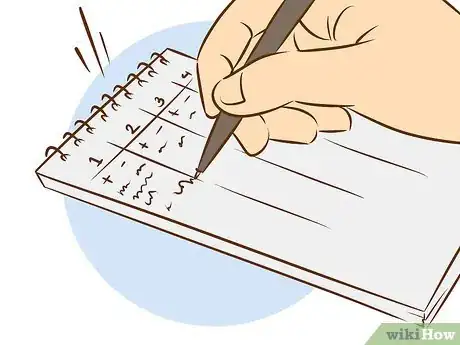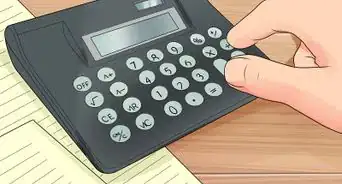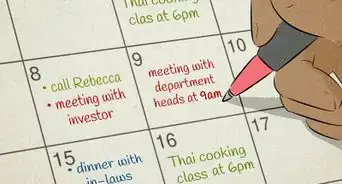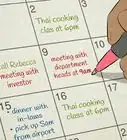This article was co-authored by Trudi Griffin, LPC, MS. Trudi Griffin is a Licensed Professional Counselor in Wisconsin specializing in Addictions and Mental Health. She provides therapy to people who struggle with addictions, mental health, and trauma in community health settings and private practice. She received her MS in Clinical Mental Health Counseling from Marquette University in 2011.
There are 19 references cited in this article, which can be found at the bottom of the page.
wikiHow marks an article as reader-approved once it receives enough positive feedback. This article received 14 testimonials and 89% of readers who voted found it helpful, earning it our reader-approved status.
This article has been viewed 1,243,056 times.
We make decisions every day; everything we say and do is the result of a decision, whether we make it consciously or not. For every choice, big or small, there's no easy formula for making the right decision. The best you can do is to approach it from as many perspectives as possible and then choose a course of action that seems reasonable and balanced at that time. If you have a big decision to make, it can seem daunting. But there are some simple things you can do to make it less intimidating, such as identifying the worst case scenario, making a spreadsheet, and following your gut instinct. Keep reading to learn more about how to make decisions.
Steps
Understanding the Source of Your Fear
-
1Write about your fears. Journaling about your fears may help you to start to understand them and make a better decision as a result. Start by writing about the decision you need to make. Describe or list everything that you are worried about regarding this decision. Allow yourself to vent about these fears without judging yourself for having them.
- For example, you might start your journal by asking yourself, “What is the decision that I need to make and what am I afraid might happen if I make the wrong choice?”
-
2Identify the worst case scenario. Once you have written about the decision you need to make and why you have fear regarding that decision, take it a step further. Try to identify the worst case scenario for each and every possible choice. Pushing your decision to the limits of what could go wrong if all goes wrong may make the process less frightening.[1]
- For example, if you need to decide between staying full time at your job or taking a part-time job in order to spend more time with your kids, think about what the worst case scenario of each decision would be.
- If you chose to keep the full time job, the worst case scenario might be that you miss out on important moments in your children’s development and that your children resent you for this when they are older.
- If you choose to keep the part time job, the worst case scenario might be that you might not be able to pay the bills each month.
- Decide whether this worst-case scenario is actually likely to happen. It’s easy for us to “catastrophize,” or spin things out to the worst possible thing that can happen, without taking the time to think. Examine the worst scenario you’ve proposed, and then consider what would have to happen to get you there. Is this likely?[2]
Advertisement - For example, if you need to decide between staying full time at your job or taking a part-time job in order to spend more time with your kids, think about what the worst case scenario of each decision would be.
-
3Consider whether the decision you make will be permanent. Once you have thought about everything that could go wrong, think about whether the decision is reversible. Most decisions are reversible, so you can take comfort in knowing that if you hate your decision, you can always make a change to fix the situation later on.[3]
- For example, say you decide to take a part-time job to spend more time with your kids. If you end up having trouble paying the bills, you can reverse the decision by looking for a full time job.
-
4Talk to a friend or family member. Don’t feel like you have to make a tough decision all by yourself. Enlist the help of a trusted friend or family member to help you or at least listen to your concerns. Share the details about the decision as well as your fears about what could go wrong. It may make you feel better to just vocalize your fears about the decision and your friend or family member may have some great advice and/or reassuring words for you.[4]
- You may also consider talking to someone who is removed from the situation and who will have a neutral opinion. A therapist can often be a helpful source for this type of perspective.
- You can even consider searching online for others who have experienced a similar situation. If you were trying to decide between full-time work and part-time work plus more time with your kids, you could post your problem on a parenting forum online. You will likely hear from people who have had to make similar decisions as well as some people who will tell you what they would do in your situation.
Considering the Decision
-
1Stay calm. Riding high on emotions, either positive or negative, can impact your ability to make a rational decision. When you have any decision to make, the first step should generally be to stay as calm as possible. If you can't stay calm, put off making the decision until you're thinking clearly.[5]
- Try taking a few deep breaths to help calm yourself down. If you have more time, go into a quiet room and do about 10 minutes of deep breathing exercises.
- To perform deep breathing exercises, start by placing on hand on your belly below your ribcage and the other on your chest. When you inhale, you should feel your abdomen expand as well as your chest.[6]
- Inhale slowly through your nose. Aim to inhale for a 4-count. Focus on the feeling of the breath as your lungs expand.
- Hold the breath for 1-2 seconds.
- Gently release the breath through your nose or mouth. Aim to exhale for a 4-count.
- Repeat this process 6-10 times per minute for 10 minutes.
-
2Get as much information as possible. Most decisions are made better when you have enough information to make an informed decision. Making decisions, especially if they're about important topics, should rely on logic. Do some research to find out as much as you can about your decision.[7]
- For example, if you were trying to decide between keeping a full-time job and switching to a part-time job to spend more time with your kids, you would need to know how much money you would be losing each month by making the switch. You would also need to consider how much time you would gain with your kids. Record this information, as well as any other relevant information that might help you make your decision.[8]
- You would need to consider other options too, and gather information about them. For example, you could ask your employer whether it’s possible for you to telecommute at least a few days a week.
-
3Use the “five whys” technique to understand the problem. Asking yourself “why?” five times can help you to uncover the source of a problem and determine if you are making a decision for the right reasons.[9] For example, if you were trying to decide between keeping your full time job and moving to a part-time job to have more time with your family, your five whys might look like this:
- “Why am I considering part-time work?” Because I never see my kids. “Why do I never see my kids?” Because I work late most nights. “Why do I work late most nights?” Because we have a new account that is taking up a lot of my time. “Why is it taking up so much of my time?” Because I am trying to do a good job and hopefully get promoted as a result. “Why do I want to be promoted?” To earn more money and provide for my family.
- In this case, the five whys shows that you are considering reducing your hours even though you are hoping for a promotion. There is a conflict here that requires further investigation in order to make a good decision.
- The five whys also suggest that this problem may be temporary -- you are working so long because you have a new account. Consider: will your hours remain this long once you are more comfortable with your new account?
-
4Think about who's affected. First and foremost, you should consider how your decision affects you. Specifically, how does your decision affect how you consider yourself as a person? What are your values and goals? Making decisions that are not “value-congruent” (i.e., they don’t align with the core beliefs that drive you) can leave you feeling unhappy and dissatisfied.[10] [11]
- For example, if a core value for you, something that is a deep part of your identity, is ambition, moving to part-time could represent a misalignment because you are no longer pursuing your ambition of getting promoted and become the top person at your company.
- Your core values may sometimes conflict with one another, too. For example, you may have ambition and family-orientedness as core values. You may need to prioritize one over the other to come to a decision. Understanding what values will be affected by your decision can help you make the right one.
- You should also consider how the problem or decision affects other people. Will any of the possible outcomes negatively affect people you care about? Take others into account throughout your decision making process, especially if you are married or have children.
- For example, the decision to move to part-time could have a positive impact on your kids because it would mean more time with you, but it could have a negative impact on you because you may have to give up on your ambition for a promotion. It may also have a negative on your whole family by reducing your income.
-
5List all of your options. At first sight, it may appear that there is only one course of action, but that is usually not true. Even if your situation seems limited, try to make a list of alternatives. Don't try to evaluate them until you've got a full list. Be thorough. If you’re having trouble thinking of alternatives, brainstorm with some family or friends.[12]
- Of course, this doesn't have to be a physical list. It can just be in your head too!
- You can always cross items off the list later, but with crazy ideas might come some creative solutions that you might not have considered otherwise.
- For example, you could find another full-time job at a company that does not require so much overtime. You could hire a person to help you with housework, freeing up your time to spend with your family. You could even set up a “family work” evening where everyone does their work together, in the same room, helping you all feel more connected.
- Research also suggests that having too many options can lead to confusion and make it harder to make a decision.[13] Once you have generated your list, eliminate anything that is obviously impractical. Try to keep your list of options to about five items.
-
6Make a spreadsheet to weigh the potential benefits and losses of your decisions. If your problem is complex and you feel overwhelmed by the variety of possible outcomes, consider making a spreadsheet to guide your decision making process. You can use Microsoft excel to make a spreadsheet or just make one on a piece of paper.[14]
- To make a spreadsheet, create a column for each possible choice that you are considering. Within each column, make two sub-columns to compare the benefits and losses of each possible outcome. Use + and – signs to indicate which items are positive and which items are negative.
- You can also assign points values to each item on your list. For example, you might assign +5 points to an item on the “Switch to Part-time Work” list called “will get to have dinner with my kids every night.” On the other hand, you might assign -20 points to an item on the same list titled “will make $900 less per month.”
- After you are finished making the spreadsheet, you can add up the points values and determine which decision has the highest score. Just keep in mind that you may not be able to make a decision using this strategy alone.
-
7Let the space between thoughts to arise. Creative people might not know it, but their ideas, decisions and solutions come at times when they are not thinking or thinking slowly. Which means creative and intelligent solutions or ideas come from a thoughtless state of consciousness. Which is why people meditate.
- Its important to ask questions and gather information or knowledge before making a decision, but if you want to come up with a truly creative and intelligent decision, you need to stop thinking or at least slow down the thinking. Breath meditation is one of the structure-less methods to bring space between thoughts that allows the creativity and universal intelligence emerge through. Its structure-less cause it doesn't require you to dedicate a lot of time, as you can become aware of you breath while doing daily tasks like cooking, brushing teeth, walking etc. For more methods and details, read Stay Rooted in Being.
- Consider an example: A musician has knowledge and information(tools) about how to make music like playing instruments, sing, songwriting etc but its the creative intelligence that comes through them that drives the tools. Yes, knowledge about music instruments, singing etc is important but its the creative intelligence that's the essence of the song.
-
8Learn to distinguish between an impulse and intelligent decision. Impulse, usually, dissolves after sometime. For example: impulse to eat, shop, travel etc. However an intelligent decision stays in consciousness for a while. It could be days, weeks or months.
- An intelligence decision may come in the form of an impulse but be aware if you feel the same way about the decision after sometime. That's why taking gaps after collecting information, by asking questions, helps to make intelligent decisions.
- Experiment: Notice the quality of actions after you take a few deep breaths as compared to when your actions arise out of an impulse.
Making the Decision
-
1Advise yourself as if you were a friend. Sometimes taking a step back from the decision can help you to determine the right choice. Think about what you would tell a good friend who was struggling with the same decision. What decision would you advise them to make? What would you try to get them to see about that decision? Why would you counsel them in this way?[15]
- Try role playing to use this strategy. Sit beside an empty chair and pretend that you are talking to yourself as if you were someone else.
- If you’d rather not sit and talk to yourself, you can also try writing yourself a letter offering advice. Start your letter by saying, “Dear ___, I have considered your situation and I think that the best thing for you to do is to ____.” Continue the letter by explaining your point of view (from an outsider’s perspective).
-
2Play devil's advocate. Playing devil's advocate can help you decide how you really feel about a decision because it forces you to take the opposite perspective and argue for it as if it is your own. If your argument against something you wanted to do starts to make a lot of sense, then you'll have new information to consider.[16]
- To play devil’s advocate, try to argue against every good reason you have for wanting to make your preferred choice. If it is easy to do, then you may find that you really want to make a different choice.
- For example, if you are leaning towards going part-time to spend more time with your kids, contradict yourself by pointing out that you spend lots of quality time with your kids on the weekends and during your vacation times. You can also point out that the money and potential promotions you will lose are worth missing out on some family dinners because they can benefit your children more than an extra couple of hours of your time every night. They will also benefit your own ambition, which is worthy of consideration too.
-
3Consider whether you’re feeling guilty. Making a decision out of guilt is common, but guilt is not a helpful motivator for healthy decision making. Guilt often twists our perception of events and outcomes so that we aren’t seeing them (or our role in them) clearly.[17] Guilt can be particularly common for working women, who face extra social pressure to perfectly balance work and family life.[18]
- Doing things because we feel guilty can also be harmful because it can lead us to make decisions that aren’t congruent with our values.[19] [20]
- One way to recognize guilt motivation is to look for “should” or “must” statements.[21] For example, you might feel as though “Good parents should spend all the time with their children” or “A parent who works X number of hours must be a bad parent.” These statements are based on external judgments, not your own values.
- So, to determine whether your decision is being driven by guilt, try to step back and examine the actual situation, as well as what your personal values (your core beliefs that govern your life) tell you is right. Are your children actually suffering because you’re working full-time? Or do you feel that way because that is how you have been told by others you “should” feel?
-
4Think about the future. At the end of the day, the best way to make a decision is to think about how you're going to feel about it in a few years. Think about what you'll think of yourself when you look in the mirror. How you'll explain it to your grandkids. If you don't like what the long term repercussions are going to be, you may need to rethink your approach.[22]
- For example, do you think that in 10 years you will you regret the decision to move to part-time? If so, why? What might you accomplish in 10 years of working full-time that you will not accomplish in 10 years of working part-time?
-
5Trust your instincts. You probably have a sense of which decision is the right one, so if all else fails you should go with your gut. Make your decision based on what feels right even if the spreadsheet says otherwise. Research has shown that people who make decisions based on how they feel tend to be more satisfied with their decisions than people who carefully weigh them out.[23] [24]
- Ask yourself what you want to do. Chances are you have a good sense of which decision will make you feel the happiest and you should lean towards that decision. It’s the change and the discomfort with the unknown that’s making the decision difficult.
- Taking some moments for quiet reflection can help you get in touch with your intuition.
- The more decisions you practice making, the more you can refine and hone your intuition.[25]
-
6Have a backup plan. Thinking ahead may help you to feel less bothered by any possible negative outcomes. Make a backup plan to deal with your worst case scenario. Even if you are unlikely to need this plan, simply having a backup plan will help you to feel better equipped deal with the worst case scenario. People who are in leadership positions are expected to always have a backup plan because there is always a chance that something might go wrong. This strategy may be helpful for making minor decisions as well.[26]
- Having a backup plan will also allow you to respond to unforeseen challenges or setbacks with flexibility. Your ability to adapt to unexpected circumstances can directly affect your ability to succeed with your decisions.
-
7Make a choice. No matter which decision you make, be prepared to accept responsibility for every outcome. If things don't work out, it's always better to have made a conscious decision than to have been careless. At least you can say that you did the best you could. Make your decision and be ready to stand by it.[27]
Warnings
- Stay away from people who make it seem as though they want what's best for you, but assume they know what that is and you don't. Their suggestions might be right, but if they refuse to account for your feelings and concerns, they might be very, very wrong as well. Also stay away from people who shoot down your beliefs.⧼thumbs_response⧽
- Avoid stressing yourself out too much. That will only make things worse.⧼thumbs_response⧽
References
- ↑ http://www.mdaap.org/Bi_Ped_Challenging_Catastrophic_Thinking.pdf
- ↑ http://www.mdaap.org/Bi_Ped_Challenging_Catastrophic_Thinking.pdf
- ↑ https://www.psychologytoday.com/blog/the-power-prime/201311/how-do-you-make-major-life-decision
- ↑ http://www.forbes.com/sites/mikemyatt/2012/03/28/6-tips-for-making-better-decisions/
- ↑ http://www.pickthebrain.com/blog/decision-making/
- ↑ http://healthland.time.com/2012/10/08/6-breathing-exercises-to-relax-in-10-minutes-or-less/
- ↑ http://www.kent.ac.uk/careers/sk/decisionmaking.htm
- ↑ http://www.mindtools.com/pages/article/newTED_00.htm
- ↑ http://www.cms.gov/Medicare/Provider-Enrollment-and-Certification/QAPI/downloads/FiveWhys.pdf
- ↑ https://www.psychologytoday.com/blog/dont-delay/201004/are-your-goals-value-congruent
- ↑ http://www.mindtools.com/pages/article/newTED_85.htm
- ↑ http://www.kent.ac.uk/careers/sk/decisionmaking.htm
- ↑ http://gbr.pepperdine.edu/2010/10/great-leaders-are-great-decision-makers/
- ↑ http://www.kent.ac.uk/careers/sk/decisionmaking.htm
- ↑ http://lifehacker.com/four-tricks-to-help-you-make-any-difficult-decision-987762341
- ↑ https://www.ideals.illinois.edu/bitstream/handle/2142/29170/useofdevilsadvoc1036schw.pdf?sequence=1
- ↑ http://www.ncbi.nlm.nih.gov/pmc/articles/PMC3490329/
- ↑ http://www.workingmother.com/research-institute/what-moms-choose-working-mother-report
- ↑ https://www.psychologytoday.com/blog/dont-delay/201004/are-your-goals-value-congruent
- ↑ http://www.wire.wisc.edu/yourself/selfreflectknowyourself/Yourpersonalvalues.aspx
- ↑ http://www.cci.health.wa.gov.au/docs/ACFE3E6.pdf
- ↑ http://www.forbes.com/sites/mikemyatt/2012/03/28/6-tips-for-making-better-decisions/
- ↑ Timothy D. Wilson et al., “Introspecting about Reasons Can Reduce Post-Choice Satisfaction,”Personality and Social Psychology Bulletin, 19 (1993): 331–339.
- ↑ http://gbr.pepperdine.edu/2010/10/great-leaders-are-great-decision-makers/
- ↑ http://www.forbes.com/sites/mikemyatt/2012/03/28/6-tips-for-making-better-decisions/
- ↑ http://www.forbes.com/sites/mikemyatt/2012/03/28/6-tips-for-making-better-decisions/
- ↑ http://www.forbes.com/sites/mikemyatt/2012/03/28/6-tips-for-making-better-decisions/
- ↑ http://www.nytimes.com/2008/02/26/science/26tier.html
About This Article
To make good decisions, wait until you're calm and clear-headed so you're not letting your emotions control your decision making, whether they're positive or negative. If you're in a rush, take some slow, deep breaths to quickly relax so you can be rational. Then, go through all of your options and weigh the pros and cons of each so you can find out which choice is the best. If you're still not sure, try going with your gut and trusting your instincts. Remember that it's OK to make the wrong decision sometimes as long as you thought it through and tried your best. To learn how to overcome the fear of making decisions, keep reading!

















































































